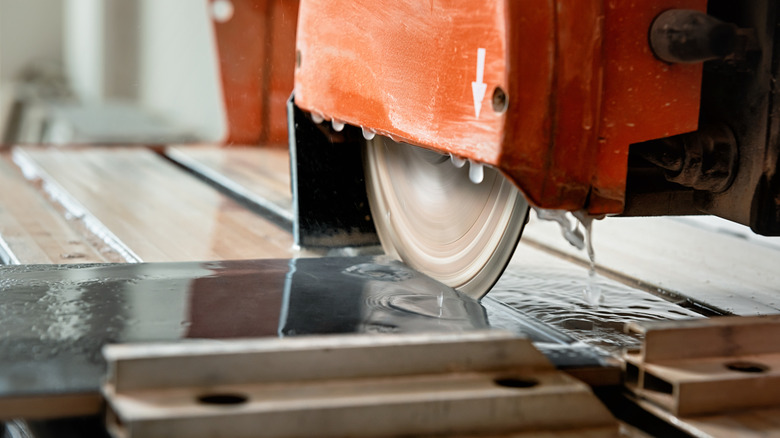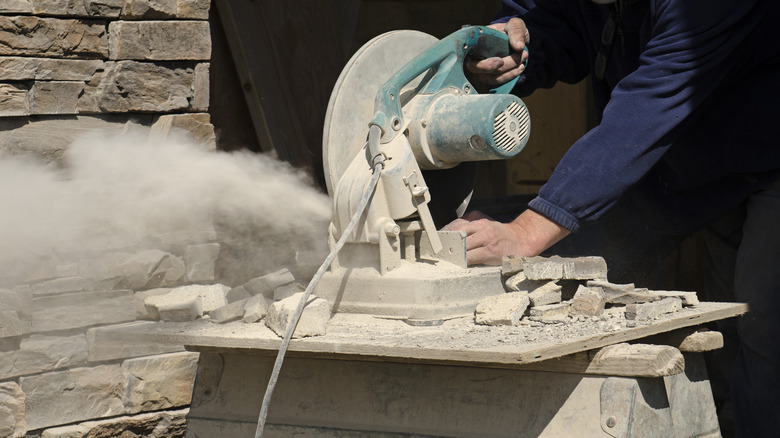Can You Use A Tile Saw To Cut Pavers? Here's What We Know
We may receive a commission on purchases made from links.
Landscape pavers are extremely versatile, making them perfect for all kinds of hardscaping projects from small patios to spacious driveways. More than just a way to add beauty and function to your yard, using pavers in your landscaping increases your home value. Available in an endless assortment of colors, shapes, sizes, and materials, it can be tempting to dream up all kinds of DIY paver projects until you start thinking about how you're going to cut them down to size. Although you can use a simple hammer and chisel, a circular saw, or even a rotary hammer, according to Carmine Argano, Owner of Creative Design Ceramic Tile & Bath, the best way to cut pavers is with a tile saw.
"In my opinion, there is no better tool than a wet tile saw for cutting pavers. Not even close," Argano said in an exclusive interview with House Digest. "You've got the precision, the clean finish, and the dust control, all in one setup." The expert recommended pairing a wet tile saw with a high-quality diamond blade. He explained that using the right tile saw will help you achieve top-notch results by "cutting through dense pavers like it's butter. No jagged edges, no bounce, no struggling." Argano sticks with tile saws for all of his company's hardscape and remodeling jobs. He uses a professional-grade machine, the MK Diamond wet saw. The manufacturer has recently gone out of business, making it challenging to get your hands on one, but a more accessible and budget-friendly option is the bestselling SKIL 7-Inch Wet Tile Saw from Amazon.
Pick the right blade for the best results
No matter which tile saw you use, Carmine Argano said there's one common mistake you should avoid. "The blade is everything," he told House Digest exclusively. "You want a high-quality diamond blade, and that's gonna run you somewhere between $75 and $150, depending on the amount of diamond material on it. The more diamond on the blade, the longer it lasts and the cleaner it cuts." Amazon reviewers love the clean cuts they can achieve with MK-225 Premium Thin-Rim Blades.
Once you've got the right tile saw, Argano said cutting pavers is a simple process. After you've set up your stand, you'll want to get your water tray ready to go. "That water keeps the dust down and keeps the blade from overheating," he explained. Then, he recommends marking your paver with a product like the iHMeiju Waterproof Carpenter Ink Pens. "Regular markers will wash right off with the water," Argano warned. "You want your line to stay put so your cut stays accurate." Finally, turn on the saw, and feed your paver through slowly. "Let the blade do the work," he said. "No forcing it, no rushing. That's how you get a clean, smooth cut with no chip marks."
Argano also noted that a wet tile saw can be used on concrete, stone, porcelain, ceramic, and other paver materials. However, if your tool doesn't have enough power, it won't get the job done — and it might even create more of a mess. "That's when you get uneven cuts, blade wobble, chipped edges, or you start smelling your motor burn out," he said.
Avoid alternatives that create dangerous dust
Choosing the right type of pavers can be a challenge, but figuring out how to cut them is simple. "Use a wet tile saw, use it right, and you won't have any issues," Carmine Argano told House Digest exclusively. "The blade stays cool, the cuts stay clean, and you don't leave a mess behind."
We asked the expert if there were any other tools or alternatives to a tile saw for people who don't have or want to invest in one. "Sure, there's technically another option: a dry cut saw," Argano told us. But he doesn't recommend them. "Dry saws kick up a ridiculous amount of dust ... That dust gets in your face, on your clothes ... It's a total mess." He also said his company never uses dry saws, and cautioned that in some places, they're actually illegal to use outdoors due to environmental regulations. Getting caught in a telltale cloud of dust can even get you fined.
Argano went on to add that anyone who thinks a tile saw can't be used to cut pavers is simply misinformed or using it wrong. "Nine times out of ten, it's because they don't know how to set it up properly. They're using the wrong blade, or they're using a weak, underpowered saw," he said, noting that trying to cut large or extra-thick pavers with the wrong size tile saw can also cause frustration. "But when used right, with a strong motor and the correct diamond blade, a wet tile saw is completely effective and absolutely safe."


